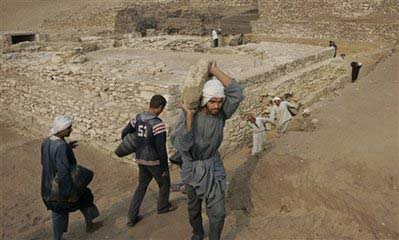
|
|
Archaeology workers carry rocks away at the site of a newly-discovered pyramid, the base of which is seen at center, at Saqqara near Cairo, Egypt, Tuesday, November 11, 2008. [Agencies]
|
The pyramids of Teti's two wives, discovered 100 years ago and in 1994 respectively, lie next to it, part of a burial complex alongside the collapsed pyramid of Teti himself.
The Egyptian team is still digging and is two weeks from entering the burial chamber inside the pyramid, where Hawass hopes they will find proof of its owner -- a sarcophagus or at least an inscription of the queen, he said.
Finding more than that is unlikely, as robbers in antiquity looted the pyramid, he said, pointing to a gaping shaft on the structure's top, a testament of the plunder.
On Tuesday, workers wearing white turbans and dust-covered robes scurried back and forth, carrying large rocks and bags heaped with sand away from the site.
Using an air brush, one worker cleaned sand from stunning hieroglyphic details on the white limestone casing, while archaeologists studied the inscriptions and students drew blueprints of the pyramid's base.
Dieter Wildung, a leading Egyptologist and head of Berlin's Egyptian Museum, said it was common in the Old Kingdom for kings to build pyramids for their queens and mothers next to their own.
"Hawass is likely right" that the pyramid belonged to Sesheshet, said Wildung, who was not involved in the dig. "These parallel situations give a very strong argument in favor of his interpretation."
But Joe Wegner, an associate professor of Egyptian archaeology at the University of Pennsylvania who has been involved in other expeditions at Saqqara, cautioned that until "inscriptional confirmation is found, it's still an educated guess" that the pyramid is Sesheshet's.
Although evidence of the queen's existence was found elsewhere in Egypt in inscriptions and a papyrus document -- a medical prescription to strengthen the queen's thinning hair -- the site of her burial was not known.
The find is important because it adds to the understanding of the 6th Dynasty, which reigned from 2,322 BC to 2,151 BC. It was the last dynasty of the Old Kingdom, which spanned the third millennium BC and whose achievements are considered the first peak of pharaonic civilization.